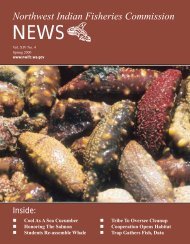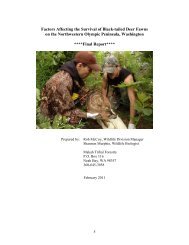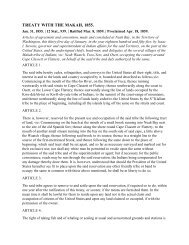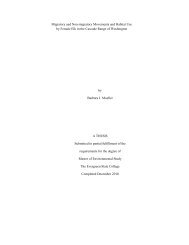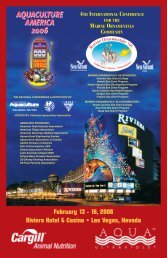Draft TRT Document â for Discussion Purposes ... - NWIFC Access
Draft TRT Document â for Discussion Purposes ... - NWIFC Access
Draft TRT Document â for Discussion Purposes ... - NWIFC Access
Create successful ePaper yourself
Turn your PDF publications into a flip-book with our unique Google optimized e-Paper software.
<strong>Draft</strong> <strong>TRT</strong> <strong>Document</strong> – <strong>for</strong> <strong>Discussion</strong> <strong>Purposes</strong> – OK to circulateaffect populations within the same river basin. Similarly, hatchery releases can confoundany correlation between two populations, especially if the magnitude of releases isdifferent and the relative contribution of hatchery fish to escapement is unknown orsubject to a high degree of uncertainty.When fish groups that are in close proximity are not correlated in abundance overtime, they are likely to be demographically independent. Alternatively, as outlined abovewhen strong positive correlations in abundance between fish groups are detected, it is notnecessarily true that the two provisional populations are really one population. The <strong>TRT</strong>considered population dynamics as a “one-way” discriminatory character. The lack of apositive correlation between populations strongly suggests demographic independence,while the existence of correlated trends does not necessarily rule out the existence ofdistinct populations. Examining trends in population abundance offers an intuitivelystraight-<strong>for</strong>ward method of establishing demographic independence; however, in practicethis criterion was only of limited use in identifying DIPs given the relatively poor qualityof escapement data. Additionally, most populations in the DPS were experiencingsubstantial declines in abundance.Environmental and Habitat CharacteristicsIn identifying demographically independent populations, environmentalcharacteristics can influence population structure in two ways. First, environmentalcharacteristics can directly isolate populations. Physical structures, falls or cascades, canisolate resident from anadromous populations or allow only one-way (downstream)migration, or anadromous populations within a basin can be separated by temporalmigration barriers (run timing) or simply distance. Thermal or flow conditions in a rivercan create temporal migrational barriers that prevent interactions between populations(e.g., the cascades on lower Deer Creek, N.F. Stillaguamish basin). Second,environmental conditions may exert a selective influence on salmonid populations, whichin turn may influence the expression of life history characteristics, producing populationsthat are highly adapted to local conditions. When life history characteristics areespecially plastic, perhaps more so with steelhead than other Pacific salmonids,environmental conditions may provide a useful parameter <strong>for</strong> identifying populations.The strength of the correlation between habitat and life history characteristics may berelated to homing fidelity and the degree to which populations in ecologically differentfreshwater habitats are effectively reproductively isolated (e.g. thermal differences mayproduce differences in spawn timing). If immigrants from other populations are less fit,they will not contribute to the long-term demographics of the receiving population.Alternatively, populations from ecologically similar regions that are geographically wellseparatedwill still function as distinct demographic units. There<strong>for</strong>e, environmentalfactors alone may have a sufficiently strong effect on the isolation of geographicallyproximate populations (i.e. a higher elevation summer run population separated from alowland winter run population by a cascade or falls) to justify their being designated asindependent populations.Classifying basins according to their predominant ecological characteristics wasuseful in comparing presumptive populations. There was some concern however that12



